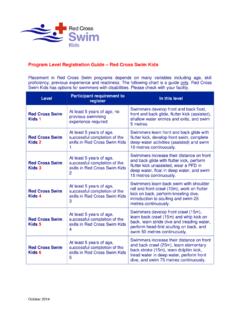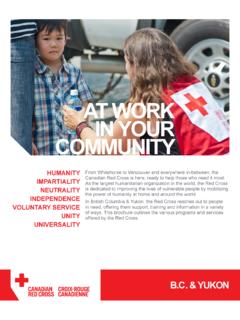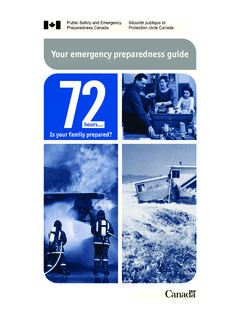Transcription of Red Cross Swim Instructor Worksheet …
1 Instructor Worksheet Red Cross Swim Preschool Starfish 1. Fitness Skills and Swimming Activities Water Safety Instructor : regiver ion and Active Supervis Day/Time: Techniques for the Ca al Participation). D AGE BASED. (Assisted). Session: (Caregiver and Child s and Exits t Help ssisted). ent sted). rm ion d). d). Buoyancy and Movem Back Position (Assiste Show How to Stay Wa PARTICIPATION AN. ). When and How to Ge Location: Shallow Water Entrie Facility/Site Orientat Submersion (Option Getting Wet (Assiste Choking Prevention Front Position (Assi Vertical Position (A.
2 Supports and Hold Choosing a PFD. Play and Songs Name and Attendance | | | | | | | | | | | | | | | |. | | | | | | | | | | | | | | | |. | | | | | | | | | | | | | | | |. | | | | | | | | | | | | | | | |. Copyright 2010 The Canadian Red Cross Society | | | | | | | | | | | | | | | |. | | | | | | | | | | | | | | | |. | | | | | | | | | | | | | | | |. | | | | | | | | | | | | | | | |. | | | | | | | | | | | | | | | |. | | | | | | | | | | | | | | | |. Recommended Class Size: 1:8 10 (With Assistant WSI, increase ratio by 4) Recommended Age: 4 12 months Total Enrolled: NOTE: Instructors keep swimmers active and wet!
3 Observation Guidelines WHEN AND HOW TO GET HELP. Caregiver describes 2 situations in which people might need help. SWIMMING. Red Cross Swim Preschool Starfish 11. FITNESS ACTIVITIES GETTING WET (ASSISTED). Caregiver knows when to get help. NOTE: Must incorporate one item from below into each lesson. With help, child experiences water on the face, head, and body. Caregiver knows how to contact EMS/9-1-1 in an emergency and Child becomes accustomed to the water. PLAY AND SONGS what information is needed.
4 (EMS is emergency medical services Using songs, caregiver and child explore different water movements and may be 9-1-1 or a community alternative.). SUPPORTS AND HOLD TECHNIQUES FOR THE CAREGIVER. ( , rocking, dancing, jumping, swinging, running). Caregiver demonstrates appropriate supports for child in the water, CHOKING PREVENTION. including: Caregiver knows the objects that may cause choking. SKILLS AND WATER SAFETY Caregiver is given a demonstration of how to identify an airway 1. Basic caregiver and child positions: caregiver (with shoulders in Prepare!)
5 Stay Safe! Survive! the water where possible) supports child under the arms while obstruction and is shown how to respond to a conscious person with maintaining eye contact FACILITY/SITE ORIENTATION AND ACTIVE SUPERVISION an airway obstruction. 2. Side-by-side positions For each lesson, caregiver and child wait for Instructor 's permission to Caregiver receives information on where to learn this technique. 3. Back float positions enter the water. CHOOSING A PFD 4. Submersion positions Caregiver and child participate in a facility/site orientation.
6 Caregiver Caregiver looks for the Transport Canada approval on the label. 5. Entry and exit positions can point out what is safe and unsafe in the pool area, including Caregiver knows how to choose the appropriate size of PFD for child. where rules are posted, hazards, and first aid station; special features SUBMERSION (OPTIONAL PARTICIPATION). PFDs that are too big will not fit properly and the child's face may be of the facility/site are discussed. NOTE: This is an optional, voluntary activity and should occur only if and covered, interfering with breathing and the child's ability to see.
7 Caregiver knows class Emergency Procedures. when caregiver and child are interested, relaxed, and ready. (Child-sized PFDs are based on weight, while adult PFDs are based Caregiver explains the importance of adult supervision when in, on, Caregiver gently submerges child. Child's ear is placed on caregiver's on chest size. The smallest PFD approved by Transport Canada is for or around the water and supervises child throughout lesson. chest so child can hear heart beat, just like when in womb. Caregiver children weighing at least 9 kg.)
8 Caregiver knows basic safety habits to prevent aquatic injuries ( , counts 1, 2, 3, Go. Caregiver and child completely submerge Caregiver knows to choose a bright-coloured PFD so that he or she check water conditions and depth, obey safety rules, never leave underwater slowly. Caregiver re-establishes face-to-face contact with will be seen from a distance. child unsupervised in or near pool, bath, etc.). child as soon as they surface. Caregiver knows that child's PFD should have a grab strap (to SHALLOW WATER ENTRIES AND EXITS (CAREGIVER AND CHILD) retrieve child if the child falls into the water), a safety strap (to BUOYANCY AND MOVEMENT (ASSISTED).)
9 Caregiver and child demonstrate safe entries into and exits from the Caregiver and child explore buoyancy and movement in the water by prevent the child from slipping out of the PFD), and a large collar water, , wading in, using ramp, steps, ladder, or slipping in from rocking side to side, turning, floating, towing, using supplementary for head support. seated position at water level. buoyant objects (kickboard, swim belt, etc.). Caregiver knows to attach a whistle or sound-signalling device so he Caregiver checks depth, hazards, and the location of other people or she can call for assistance if needed.
10 FRONT POSITION (ASSISTED). before entering the water. Child is supported by caregiver on front and allowed to move Copyright 2010 The Canadian Red Cross Society Proper fit: When all straps, zippers, and buckles are fastened, Caregiver enters the water first and maintains contact with the child caregiver knows to lift the child by the shoulders on the vest. If the arms and legs freely. at all times. PFD does not ride up over the child's face, the size is correct. Child is towed by caregiver. Child steps or is gently pulled forward into the pool from a sitting Caregiver knows that PFDs are for everyone, not just for nonswim- BACK POSITION (ASSISTED).









